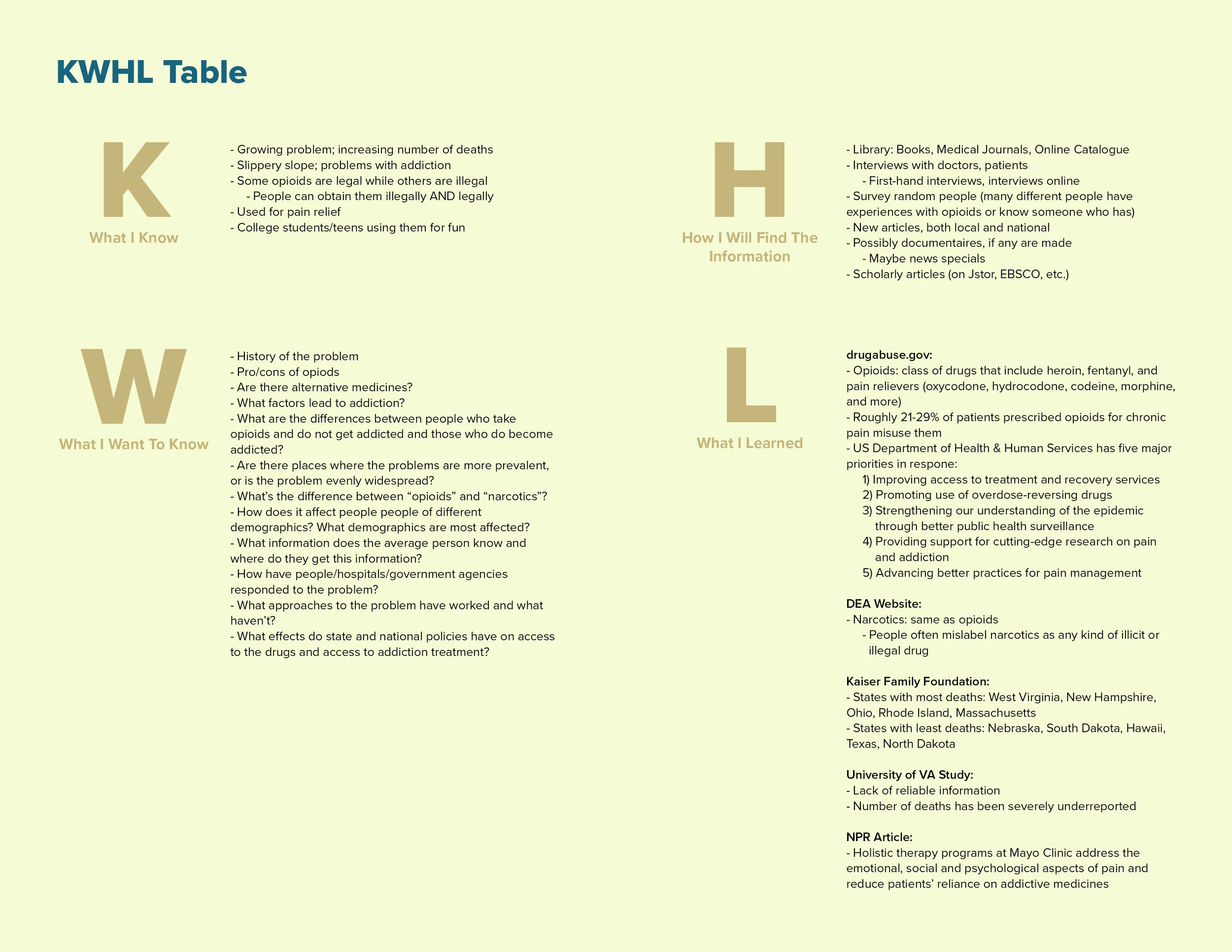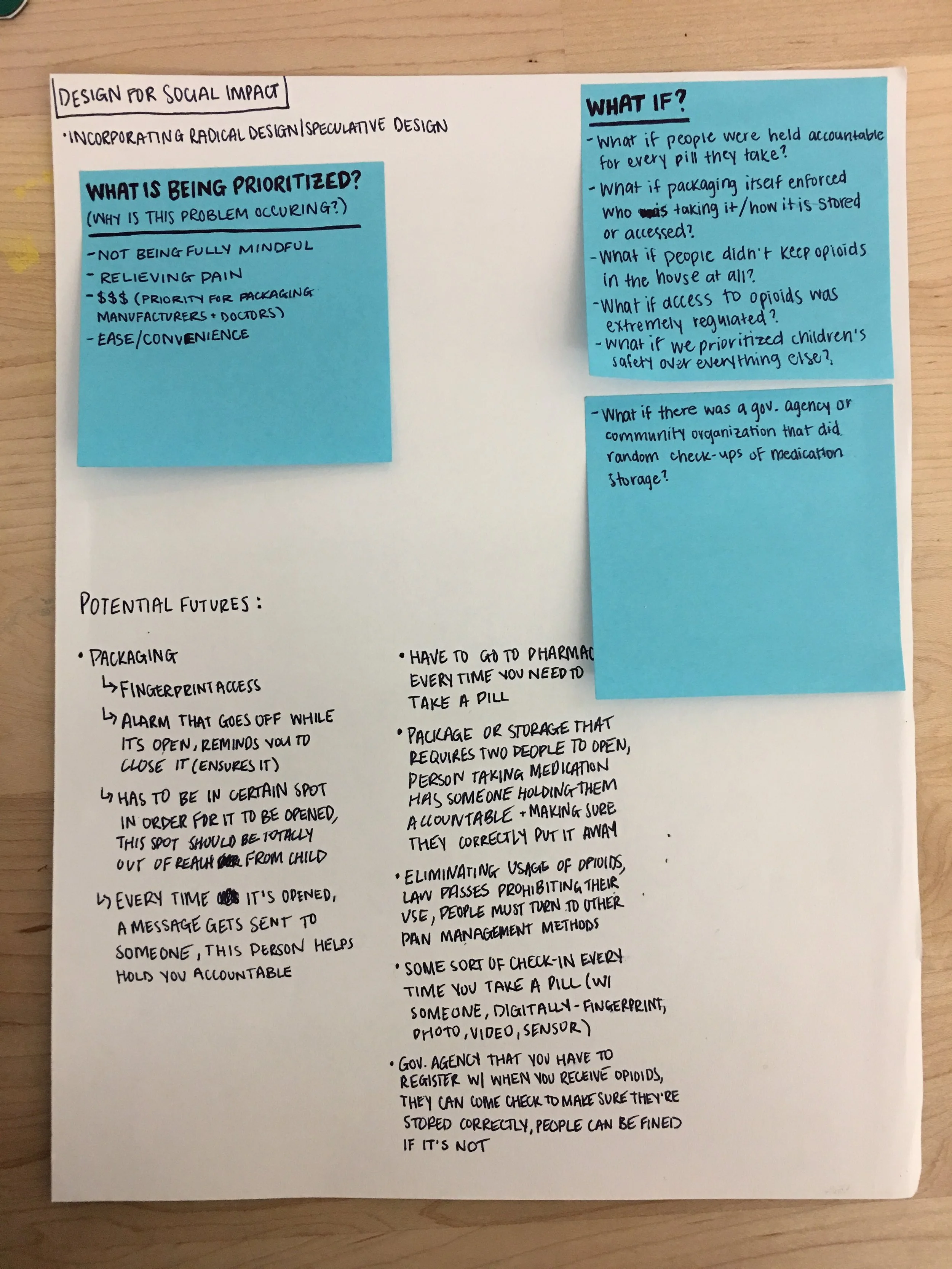Challenging Opioids
Design for Social Impact Project
Project Overview
In this collaborative project, our class worked in partnership with the Washington University School of Medicine to research and identify design-centric solutions around the use and abuse of opioids. Throughout the process we were in contact with various professionals at the WashU med school as well as members in the St. Louis community working on their own solutions. By the end of the project, we were expected to understand the application of design research methods to a real world problem, develop a strong understanding of users’ needs, and identify viable solutions to help meet these needs. The problem we were presented with was largely unframed, and we quickly realized the many different facets to the issue.
Process
To kick off the research phase, I began by creating a KWHL table which allowed me to understand what I already knew about the subject as well as do some initial research on the topic. Through the process of creating the table, I was able to recognize gaps in my own knowledge and see the initial biases I had.
In order to tackle the wide range of problems associated with opioids, our class divided into subsections of opioid usage: opioid-naive, opioid-dependent, acute need, chronic need, and pediatric. A partner and I took on pediatric need for opioids and explored the issue within this more narrow view. From the research completed in this group, we identified two age groups that opioids affected most: children under six-years-old and teenagers from thirteen to nineteen-years-old. The reasons behind opioid usage for these two groups were significantly different, so I decided to take on usage in the younger age group.
I created a 5 E Model in order for initial emersion into the problem at hand for my focus: opioid usage in children under six-years-old. The process of creating the model helped frame the problem as an experience, instead of a singular event. Upon completion, it also helped to identify pain points and areas of opportunity for potential solutions.
After gathering a wide amount of information, I created a research poster in order to clearly organize the information and see a clear focus within all the information I had been gathering. My research poster framed the problem of pediatric opioid usage in children under six-years-old by concentrating on buphrenorphine, the opioid that has caused the most admissions to a healthcare facility and the most serious medical outcomes of children in this age group. This opioid is also almost exclusively given to adults, so it highlights how parents are not properly safeguarding their medication from their children.
In order to focus my research further and humanize the problem more, I developed two personas that embody potential end users. Although the personas themselves are fictitious, their traits are based in the research completed previously. By creating these personas, it gave me end users in my target audience to keep in mind and design for as I began to develop potential solutions. I also looked at the environment surrounding these personas and the interactions that occur that result in a child taking opioids.
After creating my personas, I began thinking about potential solutions. As the target audience is under six years old, my solution had to either engage their parent/guardian or stop children from accessing the opioids. I played with the idea of education for parents through either an educational campaign or an agreement they sign with their doctor when prescribed, but these do not go far enough to solve the problem as messaging does not always stick. In addition, parents are busy people and may just accidentally leave the medication out once, but even that one time can be harmful. Because of this, I shifted my focus to the packaging and preventing children from being able to access what’s inside. I thought about the different interventions that could happen rooted in the packaging: either something that constantly reminds the parent to put the opioids away in a safe place or the package itself being inaccessible to children.
This diagram looks at the different people involved in the process that leads to children under six years old being exposed to opioids. The interactions describe what the various people actually do while the interventions describe what can be done at these different levels to prevent children from taking opioids.
As I explored my initial ideas for solutions, I kept running into difficulties; innovations in child-proof packaging have been developed, and educational campaigns don't seem to do enough. It seemed to me as though to really prevent children under six years old from taking opioids accidentally a major shift in the way we do things needed to occur. This line of thinking led me to the practice of Radical Design. Within this area of design, final products consist of artifacts that present some sort of potential future world in order to challenge the way people think. In order to develop what these worlds looked like, I constructed a list of "what if" questions and from there built potential futures.
Development and sketches of future worlds












